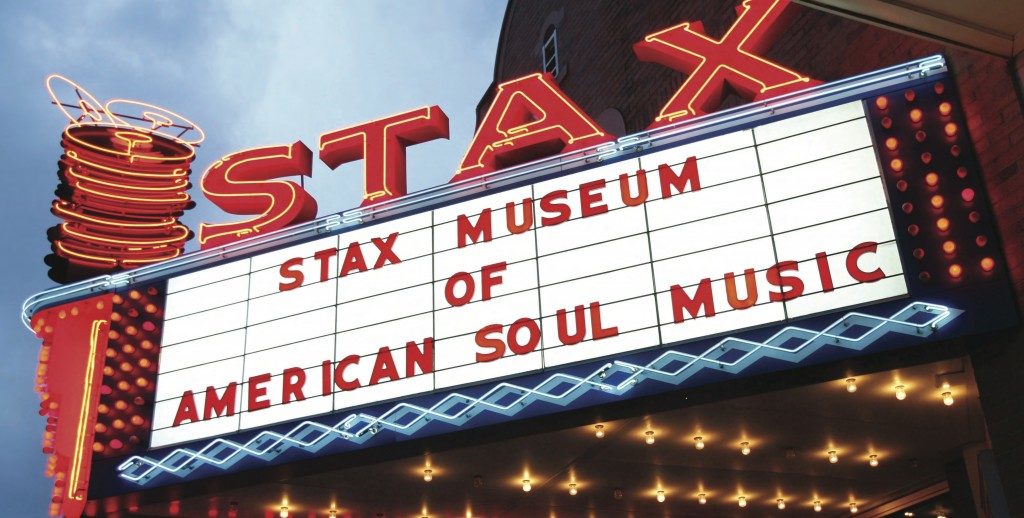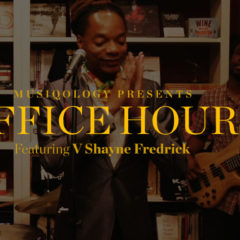It’s in the up-stroked E chords on “Green Onions,” the horns wrapping around Lynda Lydell’s “What A Man” vocal, and the crisp hi-hat hits and the wah-pedaled guitar of “Theme From Shaft.” It’s in Otis Redding’s all-or-nothing vocal on “(Try A Little) Tenderness,” the yearning lament of Carla Thomas, and the bass gravity of Isaac Hayes.
It is the STAX sound, a bricolage of soul, funk, gospel, blues, and pop sounds emanating from a converted movie theater at 926 East McLemore Avenue in the southern section of Memphis from 1960 to 1975. Two miles as the crow flies from Sun Records, where a Tupelo-born southern boy with good hair, a light baritone, and a funny name would be crowned the King, artists like Sam & Dave, The Bar-Keys, The Staple Singers, and countless others gathered, producing hit after hit and changing the landscape of popular music.
“100,000 brothers and sisters turning on to being black…telling it like it is!” the poster for WATTSTAX, the label’s 1972 Los Angeles celebration and cultural apogee, proclaimed. This was music that didn’t apologize for or “clean up” its blackness—unlike the Motown machine’s star-production factory in Detroit, STAX’s hits highlighted the humanity of its singers and players and, more importantly, acknowledged their blackness in all its beauty and complexity. STAX was a neighborhood shop in a black urban area; a young keyboard player named Booker T. Jones lived around the corner and minister C.L. Franklin’s daughter Aretha was a few blocks away.
Past the gaudy neon and the echoes of reverb bleating out of the juke joints and blues bars of Memphis’s Beale Street, today, STAX’s former headquarters still sits on a sleepy block at the corner of McLemore and College. The converted movie theater was demolished in 1989, but lovingly restored in detail, opening in 2003 as the STAX Museum of American Soul Music.
The museum starts where it ought to—in the church, with a replica of Hooper’s Chapel AME Church, which was erected in 1906 in nearby Duncan, Mississippi, just off of the now-fabled Highway 61. And while we don’t want to oversimplify things into a neat narrative, the museum’s vision of one isn’t unreasonable. It walks visitors through its own humble history, connecting STAX to the longer narrative of the soul-blues-gospel fusions, birthed in churches of the American South, coming of age with group harmony and vocal quartets, and reaching maturity at STAX, where the unabashed youthfulness of its musicians created the unique sounds that would give the label its important place in history despite its small size.
One surprise as you walk past Booker T’s Hammond B-3 and Isaac Hayes’s 1972 Oscar (awarded before a single black artist had taken Album of the Year at the Grammys), though, is the extent to which any whiff of racial acrimony is minimized in many of the after-the-fact reflections that the museum performs. Despite the black Santa Claus advertisements, Isaac Hayes’s chains, and Jim Stewart and Estelle Axton (the ST and AX from whence the label gets its name) both appear in the museum’s introductory video montage, making a clear emphasis: “STAX didn’t see race.”
We might put a finer point on this—STAX’s white founders didn’t want to be defined by the race of the label’s famous faces. And the importance of STAX’s black brand could be de-emphasized by the very people whose position on the “normative” side of the white/black binary needn’t experience “race.” “Not seeing race” was only a virtue to a certain sort; and the disconnect of celebrating this in the museum could not be shaken as we walked past the albums released by the label—Earth, Wind & Fire’s Sweet Sweetback’s Baadasssss Song soundtrack, Richard Pryor’s That N*gger’s Crazy, and, of course, Black Moses.
And we might thus ask: Who is the STAX museum for? Why is the “best” version of the STAX story one that oversimplifies the racial dynamics of the city into a multicultural paradise?
Sometimes a place can be both uniquely itself and an allegory for the world around it; STAX is that place for Memphis today. An almost palpable discomfort with regard to race remains — there is an “official” Memphis story that is tailored to the universal tourist, who’s there for Graceland and Sun Records and maybe a trip down Beale Street, which on a Sunday evening is quiet, with just a few guests at each of the blues bars.
And yet race, certainly after the tragic events of April 4, 1968, is inescapable. The Lorraine Motel is still there; so, too, is a wreath on the balcony outside Room 306 where the Reverend King fell, a replica of the one hung the morning after as the crowds gathered. The hotel, once Green Guide-approved a safe haven for black travelers in the segregated South, fell into bankruptcy. In its high times, STAX artists would stay there when recording on College and McLemore; Isaac Hayes recalled eating fried chicken in the pool and “In the Midnight Hour” and “Knock On Wood” were said to have been composed there. A marble headstone, set at the site a few days after April 4, quotes Genesis, a searing, boldly confrontational choice made by Ralph David Abernathy, who was occupying the second bed in Dr. King’s room: “They said to one another, behold here cometh the dreamer. Let us slay him and we shall see what will become of his dreams.”
The Reverend Martin Luther King Jr.’s assassination likely did not—as Booker T. has at least apocryphally suggested—kill STAX. But a kind of racial balance was upset at that moment for the city, and the STAX project of repair is at best a reconciliation and at worst a transparent attempt at revisionist history for tourists’ eyes. The Memphis Sound is Mavis and Sly and Otis, he himself lost far too soon. The Memphis Sound is also in the bus driver’s voice that threatens you as you step onto the replica bus at the National Civil Rights Museum, a site that should be required visiting for all Americans. It’s in the “no” eight-year-old Gerald Young received as he tried to enroll at all-white Vollentine Elementary in 1958 and failed. It’s in the sound of the gunshot.
The Memphis Sound is bold and alive and daring and collaborative and complicated and historic and black and white and joyous and sad all at once. And it sounds wonderful.



 Share On Facebook
Share On Facebook Tweet It
Tweet It








